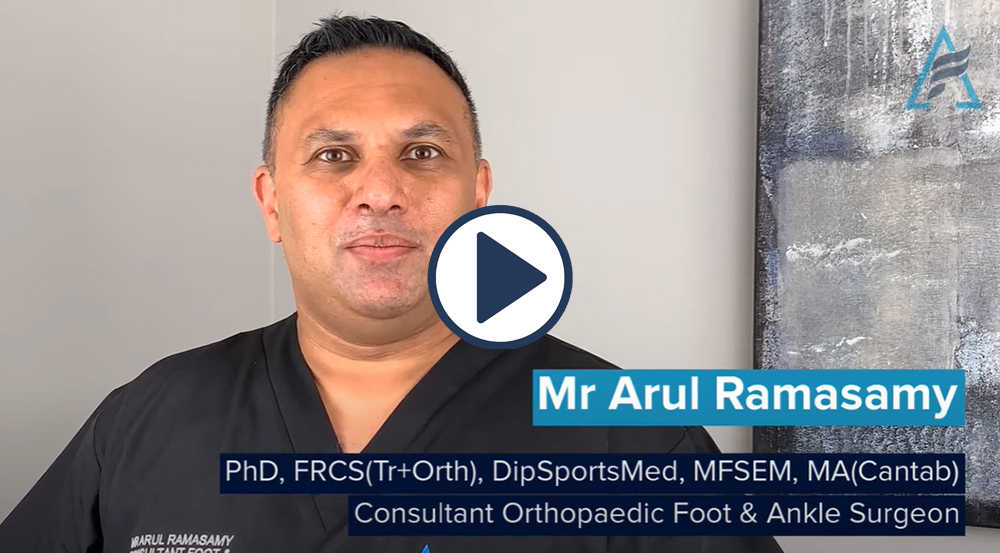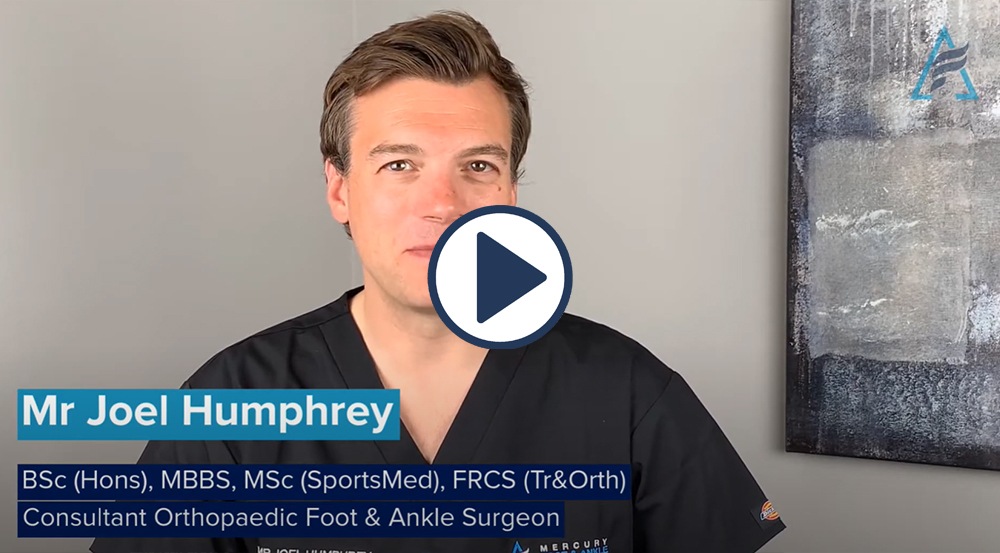Ankle Arthroscopy

What is an ankle arthroscopy?
An ankle arthroscopy is an operation performed using a “keyhole” technique to allow the surgeon to directly see and operate inside the ankle joint.
What happens during an ankle arthroscopy?
In most cases the operation is performed under general anaesthetic (whilst you are asleep). Alternatively, you can have a spinal or regional anaesthetic, which just numbs the leg.
The operation involves small surgical cuts (about 1cm) on the front and / or back of the ankle joint, to allow instruments to be inserted into the ankle. Initially a small instrument containing a thin fibre-optic camera (arthroscope), that magnifies and transmits images to monitor, is used to look inside the ankle joint to see what is causing your symptoms (diagnostic). Additional small specialist instruments are inserted into the ankle joint to perform any necessary treatment. Then the ankle is cleaned out, the wounds are closed with stiches and a bandage is applied.
What can be done during an ankle arthroscopy?
An ankle arthroscopy directly sees into the joint and can help in making a diagnosis, although you will often have a scan prior to surgery. Procedures performed arthroscopically include removal of bony spurs (osteophytes), inflamed tissue (synovitis), scar tissue (arthrofibrosis) or loose bodies (cartilage or bone). If there is damage to the joint surface (osteochondral defect) this can be treated with small holes being drilled into the bone (micro-fracture) to promote healing or cartilage transplant procedures. An ankle arthroscopy can be used to perform major surgery (e.g. ankle fusion) or used in conjunction with another ankle surgery (e.g. lateral ligament reconstruction).
What are the risks?
The risks of any operation generally relate to the anaesthetic and the surgical procedure.
You will be able to discuss your anaesthetic options and associated risks with the anaesthetist before your surgery. With a general anaesthetic, the risks will vary depending on your general health.
The main surgical risks of an ankle arthroscopy are listed below, but it is not exhaustive. These will be further explained in the outpatient clinic.
Numbness– The commonest problem, although unusual, is numbness on top of the foot or outer toes. Small nerves in the skin can get stretched during surgery. Numbness mostly resolves in time, but it can persist.
Infection– The wounds usually heal within two weeks. In a small number of cases the wounds become infected. The majority are minor infections that can be simply treated with antibiotics. Occasionally, some patients can develop a deeper infection that might require another operation.
On-going symptoms– The success rate of the operation depends on the problem and treatment performed. The majority of patients will notice an improvement in their symptoms; however, some patients may have on-going pain and stiffness. The ankle can be swollen for months after surgery.
Blood clots (leg or lung) – There is small risk of developing a blood clot after ankle surgery. Measures are taken to reduce the chance of this happening but cannot be completely avoided.
Chronic regional pain syndrome – Following foot and ankle surgery, a very small proportion of patients can develop chronic regional pain syndrome. Your foot becomes indefinitely painful, swollen and sensitive. If you develop this, you may require specialist care from a pain consultant.
Other risks- joint damage, sensitive scars, neuroma, nerve injury and vessel injury.
Are there any alternatives?
Managing your pain with painkillers, physiotherapy and activity modification are all beneficially alternatives. Ankle arthroscopy is generally only recommended as a last resort, once all non-invasive measures have been exhausted. Patients with severe ankle arthritis may not benefit from arthroscopic “clean up” surgery.
What happens after my operation?
When will I go home after surgery?
Most patients can go home on the same day of surgery. You may require an overnight hospital stay in hospital if you have other significant medical problems or if you have more major surgery (e.g. ankle fusion).
Will I be able to walk on it after surgery?
The amount of weight you can put through your operated leg will depend on the treatment performed during your ankle arthroscopy. You will be guided by your surgeon. Before you go home the physiotherapist will make sure you are safe to get around on crutches.
In the first few weeks keep your leg elevated as much as possible to help reduce the swelling and aid wound healing. It is important that your bandage remans dry and you may find using a waterproof cover helpful (www.limboproducts.com).
When will I be seen after surgery?
You will be seen two weeks after surgery in the outpatient clinic. Your wounds will be checked and the stitches removed. You can then start wearing your own footwear.
You will then be seen again six weeks after surgery and referred to our specialist physiotherapists. Further appointments will depend on your individual progress.
When can I go back to work?
If you have a sedentary job (desk based) and are able to elevate your foot, you can return to work two weeks after surgery. If you have a more physically strenuous job, you may need longer off work.
When can I drive?
You can start driving when you are comfortably walking in your own footwear. If you cannot safely make an emergency stop your insurance will not cover you in the event of an accident. Start by sitting in the car and trying the pedals, then drive round the block. Drive short distances before long ones.
How quickly can I return to sports activities?
It varies how quickly people can take up sports activities again. Generally, for the first six weeks after surgery any impact exercise is best avoided. It can take at least six months to return to your normal level of sporting activity. You will be guided by our physiotherapists during the rehabilitation program.
When can I fly after surgery?
If you are flying after recent surgery you are at an increased risk of developing a blood clot in one of the deep veins in your body, usually the leg (deep vein thrombosis or DVT). Please ask your surgeon for individual guidance on how long to delay flying after your surgery. Also, each airline has its own regulations about flying after surgery and you will need to check with your airline before flying.
Wellbeing Advice
Patients that have a healthy diet, take regular exercise and refrain from smoking are more likely to experience a quicker recovery with a more successful outcome from their surgery.
Taking vitamin C supplements for six weeks before surgery and six weeks after surgery can also be beneficial. You can purchase them from your local pharmacy or supermarket.
If you have any concerns about your general health and well-being (diet, exercise, smoking cessation) you are encouraged to discuss this with your GP, who will be able to provide advice on the options available to you.
We hope this leaflet has answered any questions you might have. If you have any further queries, please feel free to discuss them with any of the medical or nursing staff.
Testimonials

My condition had deteriorated to the point that I was unable to walk for extended periods of time without pain and swelling of the ankle, and I would rarely be able to join in most family activities. The support and guidance provided by Mr Ramasamy were exemplary and enabled me to make a fully informed decision regarding the options available to me. Now, the pain is much more manageable and the stability that the treatment has provided is such that I feel that I regained a significant part of my life and as such my confidence.
I found Mr Ramasamy extremely professional and reassuring. On the day of my procedure I received the most efficient, organised and professional care in my life. Your nurses were the best I have ever experienced. Mr Ramasamy’s team, in theatre made me feel at ease and made the whole procedure more bearable. They go way beyond the extra mile for their patients.
I wanted to share my excellent experiences and compliment Mr Ramasamy and his team. I found him extremely professional and reassured that he understood how much pain I was in. On the day of my procedure, it was the most efficient, organized and professional care I have ever received – from checking into reception to being allocated a bay and taken into theatre – your nurses in the recovery area were the best I have ever received. Mr Ramasay’s team, especially in theatre, made me feel at ease, kept me informed throughout the whole procedure and made the whole procedure more bearable.
Send Us A Message

If you have a question or want to reach out to us directly, use the contact form below and send us a message.








